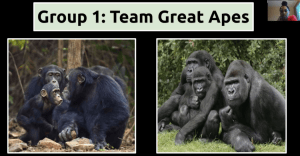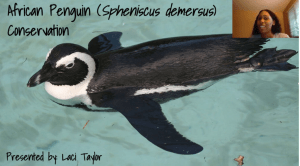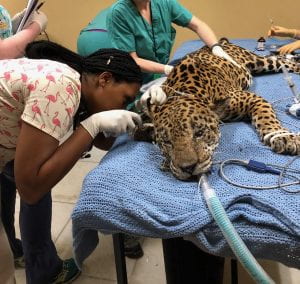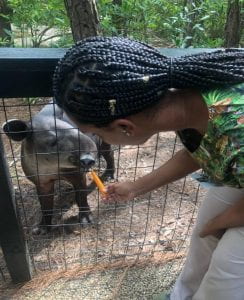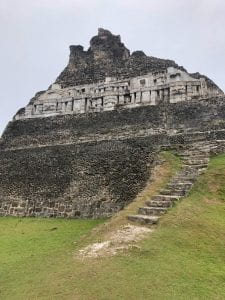As an aspiring veterinarian interested in zoological medicine, I have tried my best to take advantage of all zoo and wildlife opportunities available to me. When I think about the kind of veterinary career I want to have, it is one where I can combine my interests in conservation, international travel and cultural immersion. For this reason, I am sure you can imagine my excitement when back in January, I was accepted to work at the Jane Goodall Institute (JGI) in Uganda for the summer of 2020. For eight weeks this summer, I would have been assisting the JGI team with disease monitoring in habituated chimpanzee populations, transmission analysis of infectious diseases between humans and chimpanzees, and community awareness. My proposed project aimed to reduce disease transmission risk for humans and wild-habituated chimpanzees in Kibale National Park to improve public health and conserve this endangered population of chimpanzees. I was particularly excited for this opportunity because it would have been my first veterinary experience that encompassed the topic of conservation with communities. Conservation with communities is an approach to conservation that includes the local people in an effort to make the conservation initiatives more sustainable. It is a concept that I am passionate about because I believe that involving the local community in conservation initiatives helps to better sustain these initiatives.
Like many other students whose summer experiences were cancelled due to the coronavirus (COVID-19) pandemic, I was devastated. Not only would I no longer get to participate in this once in a lifetime experience, but also I did not have any other summer opportunities lined up. Having traveled back home once classes went virtual, I was no longer able to work my hospital job as a student technician at the Wildlife Health Center and many local practices were not accepting new hires for safety reasons. As a result, I spent my first couple of weeks back home scrambling for summer experiences. That is, until one of my professors reached out to me about an opportunity to become a teaching assistant for his three-week virtual summer course on conservation. The course was offered through Cornell University College of Veterinary Medicine for credit and geared towards high school students. This would be the first time that the course would be virtual. Something I really enjoyed throughout my undergraduate career was teaching so I happily accepted the position.In undergrad, I gained teaching experience mainly through planning and leading educational activities through the student run organizations I was a part of, but this would be different.
As a teaching assistant I had a lot of responsibilities. I was responsible for managing and organizing the course website, securing guest lecturers, managing discussion boards, creating and grading quizzes, developing course feedback surveys and providing feedback on and grading final projects among many other responsibilities. I was even responsible for creating and leading my own lectures and labs. Some of the topics I gave lectures on were the role of veterinarians in zoos, zoonotic diseases of companion animals, disease transmission at the wildlife-livestock interface and illegal wildlife trade. I was even able to integrate the concept of conservation with communities into some of my lectures!
One of the activities I enjoyed leading the most was on disaster preparedness in a zoo setting. I worked closely with Dr. Abou-Madi to put this activity together which tasked students with acting as a cohesive team to build the different parts of a disaster prevention plan. Following a presentation on disaster preparedness and prevention, students were divided into teams each with a different animal grouping and their job was to look at all the different aspects that are necessary to best prepare and act quickly in the midst of a tropical storm to protect the animals in their grouping. The teams were also tasked with addressing the basic medical needs of the animals they were assigned to as part of their plan. For example, one student group had Komodo dragons as their animal grouping and some of the Komodo dragons had spinal lesions caused by salmonella while others were intermittent shedders of salmonella. In order to come up with an effective disaster prevention plan, students were encouraged to consider how they would secure and care for the animals during and after the storm hits, decide where to best locate the animals, and how to distribute the animals in the selected shelter among many other considerations.
I did not quite know what I signed up for when I agreed to be a teaching assistant for the course, but I am so glad I did! Throughout my time as a teaching assistant, I gained organizational skills such as carrying out administrative tasks, and strategic planning and decision making. I also further developed my communication skills through teaching, interacting with students and through collaborating with the rest of the core course planning team. I was also able to develop critical thinking skills through coming up with creative ways to make virtual lectures and labs interactive and troubleshooting technical difficulties. Becoming a teaching assistant was a really great way to develop my soft skills and is an experience I highly recommend to other veterinary students.
ABOUT THE AUTHOR
 Laci Taylor, class of 2022, is a DVM student at Cornell University College of Veterinary Medicine. She is interested in wildlife and aquatic medicine and hopes to make a global impact as a wildlife veterinarian. Laci hopes to promote biodiversity through rehabilitation and conservation – fields that serve as pathways for understanding many pertinent issues today from the transmission of zoonotic diseases which affect public health, to restoring endangered species.
Laci Taylor, class of 2022, is a DVM student at Cornell University College of Veterinary Medicine. She is interested in wildlife and aquatic medicine and hopes to make a global impact as a wildlife veterinarian. Laci hopes to promote biodiversity through rehabilitation and conservation – fields that serve as pathways for understanding many pertinent issues today from the transmission of zoonotic diseases which affect public health, to restoring endangered species.

